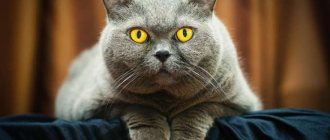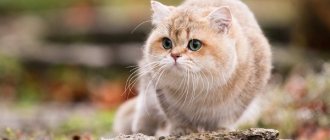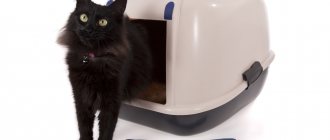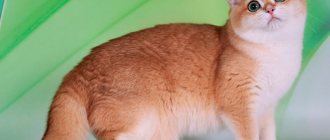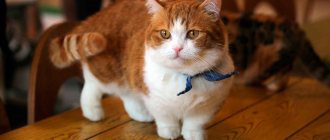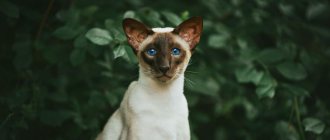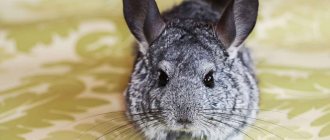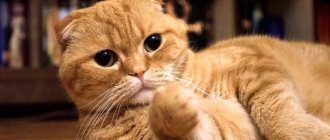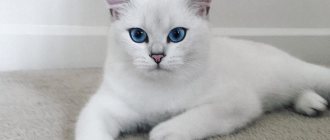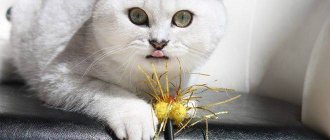A person who keeps pets gets sick 5 times less than other people. Whether the information is true or just speculation from pet lovers is unknown. But there is no doubt that the appearance of a British chinchilla cat will have a beneficial effect on the mood of all family members. The appearance, color of the plush beauty, character, habits, everything speaks about the difficult origin of the pet.
Characteristics of the British chinchilla - character and behavior
Speaking about the characteristics of the breed, it’s worth saying right away that the British chinchilla is an aristocrat among cats. She quickly and easily gets used to her owner and his family, feeling like a full-fledged member of society. But at the same time, the cat avoids excessive displays of feelings, preferring to love everyone in silence. In addition, she does not like excessive attention - if you pet your pet too actively or hug him too much, the British chinchilla will get up and go to a quieter place. Because of this, they are perceived as cold and unfriendly animals.
Kittens quickly learn the rules of living in a family if they are clear and well formulated. They will never crap past the litter box, climb onto the bed, or steal food from the table, but to do this, the owner must immediately confront the pet with these facts and be adamant. You should not hope that after the cat has slept on the owner’s pillows several times and has not been punished for it, he will give up this pleasant habit.
It’s nice that even in a small apartment, a Briton will not cause unnecessary problems for the owners. They don’t rush around the rooms like crazy and don’t wake up the owner with howls if at three o’clock in the morning they suddenly want a snack and the cup is empty. Therefore, if you love cats, it will be difficult to find a better pet than the British chinchilla.
British kitten weight table by month
The weight of a British cat, as can be seen from the table, changes unevenly with age: the animal’s muscle and fat mass grows most rapidly in the first month, then slows down. At one year of age, the British pet actually reaches its maximum weight, and the weight stabilizes at 2.5 years.
| age | female, kg | male, kg | peculiarities |
| newborn | 0,07–0,15 | 0,08–0,15 | newborn kittens of the British breed are quite large |
| first week | 0,1–0,25 | 0,25–0,3 | a nursing cat needs to be well fed, food must be rich in vitamins and balanced, so that the cubs develop fully |
| second | 0,15–0,35 | 0,35–0,4 | by this time, British kittens should weigh approximately 1.5 times more than at birth, the eyelids of large and developed cubs open |
| third | 0,2–0,4 | 0,4–0,65 | you can gradually introduce complementary foods, especially if the litter is large and the kittens are weak |
| first month of life | 0,25–0,6 | 0,55–0,7 | as complementary food, they give boiled beef or chicken minced in a meat grinder or blender, sea fish fillet, soft canned cat food, cottage cheese, boiled yolk |
| 2 months | 0,45–0,9 | 1–1,7 | |
| 3 | 1–1,5 | 1,5–2,5 | if the cubs are still fed with mother's milk, then the feeding should be more balanced and rich in vitamins |
| 4 | 1,8–2,4 | 2,2–3,9 | |
| 5 | 2,2–2,9 | 2,6–4,3 | Before becoming an adult, a British kitten must gain the same number of kilograms as at 5 months of age |
| 6 | 2,3–3,6 | 3–5,4 | |
| 7 | 2,4–3,8 | 3,3–5,6 | |
| 8 | 2,5–4 | 3,5–6 | |
| 9 | 2,5–4,2 | 3,8–6,4 | |
| 10 | 2,5–4,3 | 4,1–6,6 | |
| 11 | 2,5–4,3 | 4,2–6,7 | |
| year | 2,5–4,5 | 4,5–7 | Once a British cat has become mature, it is prohibited to give fatty meats, smoked meats, fatty dairy products, river fish (they may contain helminths), bones (they are poorly digested in the stomach) |
Description of the breed - what does a British chinchilla cat look like?
When choosing a suitable pet, it is advisable to take into account not only the character, but also the external description. On the one hand, this allows you to make sure that this breed will be a good choice. On the other hand, it reduces the risk of acquiring a purebred cat with defects. Therefore, this point should be described in more detail.
Appearance
The head of the British chinchilla is wide, massive and at the same time almost round. The transition of the forehead to the muzzle is clear and pronounced when viewed from the side. The skull is strong and has smooth, rounded contours. The forehead should be convex - a flat one is considered a gross defect. The cheeks are also rounded and full, making the pet’s face look elegant and cute. Wide cheekbones further round the head visually.
The nose is wide, but short and straight. The length is most often average. Strong, well developed chin. The ears are set wide apart and are of medium size. They are wide at the base and gradually taper towards the tips to end in a graceful curve. Large, almost round eyes are set wide. Eye color depends on the main color – we’ll talk about this a little later. But it must be rich.
The body can be either large or medium. The muscles are well developed, the physique is strong. The back is straight. The chest is strong and deep, smoothly flowing into broad shoulders. Body of medium length, stocky. The tail is thick at the very base, but tapers neatly towards the tip. The length of the tail is 70% of the length of the body.
Size
The British Chinchilla has a height at the withers of about 35 cm. And a strong physique gives the cat solidity and confidence.
Weight
Thanks to their powerful build, British chinchillas weigh a lot. Typically, adult cats reach a weight of 5-8 kg, and among sterilized cats living in small apartments, and even eating well, it is not uncommon for an indicator of 10-12 kilograms. Cats are noticeably smaller than cats - they usually weigh only 3-4 kilograms. True, if your pet is sterilized, she will actively gain additional weight and can reach 6-7 kilograms.
Wool
The wool is plush and moderately soft. Not too long, but at the same time longer than short-haired breeds. Pleasant to the touch, with a delicate texture. Doesn't fit tightly to the body. The undercoat is abundant and pronounced. Both too coarse and too soft wool are not allowed - here connoisseurs of the British chinchilla have strict requirements. A long-haired chinchilla is also likely to be rejected at the show.
Colors
Chinchilla color comes in two varieties: tipped and shading. In the first option, the wool is partially colored - the base remains white, and the very tips, about 1/8 of the length, are colored the main color.
Shading or shaded is a little different. The wool is also partially dyed, but more intensely - the hair is dyed about a third of the length.
The breed standard allows for many color options. The main ones include:
- White wool,
- blue (and also blue gold),
- redhead,
- black,
- gray,
- gold (or, as an option, golden - according to the standard marking BRI NY 12),
- silver
But a marbled cat or a representative of the breed with a point color is definitely considered a defect - such colors are not found in purebred British chinchillas.
Appearance
British Chinchilla is medium or large in size, there are individuals weighing up to 8 kg. Distinctive features of the breed:
- dense build;
- round massive head with widely spaced, slanted ears;
- powerful skull;
- upturned nose;
- pronounced outlines of the cheeks;
- firm chin;
- thick, large tail with a rounded end; the fur on it is usually longer than on the entire body;
- strong paws; due to the dense fur coat they appear shorter, which gives the animal a squat appearance;
- velvet wool;
- thick undercoat.
Girls are significantly smaller than British chinchilla cats. But a sterilized adult can reach 10 kg. It is very important to prevent pets from becoming obese. It is necessary to follow a feeding schedule and maintain the physical activity of your furry friends. With proper health care, the appearance of the animal will delight the owner.
Eyes
British chinchillas have large, shallow-set eyes of various green colors. It took a while for experts to achieve such a bright emerald hue. Blue and yellow eyes are found in varieties of the British chinchilla breed. A characteristic feature of the animals is the bright black rim of the eyes. It makes the pets look more expressive.
Are British Chinchilla cats hypoallergenic or not? How often do they shed?
Cats of this breed shed twice a year - in the off-season, replacing summer coat with winter coat and vice versa. At this time, they need special care - they will have to be combed three to four times a week, or better yet, every day. But even with this there will be a lot of wool. And the rest of the time, molting occurs constantly, although not so intensely.
The British chinchilla is not hypoallergenic. If there are people in the family who suffer from allergies to cat fur, then you definitely shouldn’t get a British chinchilla.
Is the British Chinchilla a friendly breed?
There is an opinion among some animal lovers that this breed is not very friendly. Allegedly, she does not like affection and tries to stay away from people who often pet her.
Actually this is not true. The British chinchilla, like any other cat, loves affection. She loves to lie on her owner's lap while he affectionately scratches behind the ear.
But at the same time, she has an aristocratic measure of intimacy. When petted, the pet purrs happily. But if you cross a certain line - forcefully hold him on your knees, hold him tightly to you, or press hard while stroking him, the Briton will definitely not tolerate this and will try to sneak away. Therefore, when getting a cat of this breed, be prepared for the fact that she will respect you if you are ready to treat her with respect.
Colors
The main types of color are considered to be golden British and silver variants. But other shades are known, more than 30 in total. The black version of the shade is considered rare: with age, the rich color turns into dark brown or chocolate.
Golden
The British Golden Chinchilla's coat resembles that of an Arctic fox. Fur color is soft peach or cream, reddish. At the end of the hair the shade becomes darker or turns into a bright smoky color. Options for alternating colors:
- Brown.
- Dark grey.
- Ginger.
The tail, ears and sides of the body usually have a richer color. The color should be even, without spots.
Silver
The dominant color of the British Silver Chinchilla is white. The tips of the fur are 80% black. It gives the impression of shimmering silver and shine on the back and tail. A distinctive feature is the pure white undercoat. The British point chinchilla has a very light shade of fur, almost snow-white.
Ticked
The ticked representative of the breed is evenly covered with alternating stripes: smooth transitions of dark and light shades. On the back the ticking is usually more noticeable.
Shaded
The coat of a shaded chinchilla is 1/3 darker than the main shade. The undercoat, like that of a silver chinchilla cat, is pure white. A rich shaded transition to the chest and tummy is possible. The tail is black at the end.
White
There is an opinion that a variety of silver colors are mistaken for white chinchillas. The owner of an impeccably white coat has a uniform uniform color along the entire length of the coat. The white British chinchilla has a wide range of eye shades: from blue to soft gold.
Blue
The British Blue Chinchilla was recognized much earlier than the Golden Chinchilla.
british chinchilla photo
british golden chinchilla
british golden chinchilla
silver chinchilla
silver chinchilla
silver chinchilla
silver chinchilla
silver chinchilla
silver chinchilla
Attitude towards children
Almost always, British chinchillas have a peaceful relationship with children. They are smart enough to forgive human kittens some mistakes. Therefore, if they try to pull the tail or lift it, awkwardly grabbing the stomach, the cat will probably not use its teeth or claws. Instead, he will hastily, but with a certain grace, retreat to a place that is inaccessible to children. The main thing is to teach the latter that the pet has a certain place where he can be alone - for example, a box or a cat house. Now, if an overly intrusive child tries to pull the cat out of the shelter, which she is accustomed to consider inviolable, there is already a possibility of conflict. But in general, the British chinchilla is not at all predisposed to aggression.
Relationship with the owner
Cats quickly find a common language with their owner and play with children. The British are prone to apathy. The chinchilla cat loves to be given attention and entertained.
If the owner is busy and cannot pay attention to the golden or silver chinchilla, it becomes offended and begins to get bored. The animal loves to be nearby when the owner is reading a book, watching TV, or doing homework. He will sit in your arms exactly as long as he wants.
The cat is imposing, allows itself to be stroked and scratched behind the ears. But he does not tolerate familiarity. As soon as the owner begins to squeeze the cat or tries to pat it, the pet expresses dissatisfaction. They are the kind of animals that allow themselves to be loved and set their own rules.
Attitude towards other animals
How relationships with other pets will develop depends solely on their behavior. The British chinchilla does not have a tendency to conflict. However, this aristocrat will not tolerate infringement of his rights. Relationships with large dogs are friendly. A cat and a dog can become friends - sleep together, eat from the same bowl. With small dogs that bark a lot and often try to assert themselves at the expense of others, relationships will most likely be strained, and there is even the possibility of conflicts.
British chinchillas are reserved with cats, but, as a rule, they do not show excessive affection. Relations are calm, even, but not too friendly. Although, if the neighbors try to dominate and oppress a native of Britain, things may end in a fight.
British chinchillas will not make friends with small rodents, such as rats, mice or hamsters - they are perceived exclusively as potential prey. Therefore, it is better not to leave your pets alone, at least if the lives of small animals are not protected by the glass of the aquarium or the metal bars of the cage.
Mating, pregnancy and childbirth
To maintain conformation, breeders follow one rule - to breed cats of the same color. That is, gold with gold, silver with silver. Otherwise, the “blurred” color will undergo unsuccessful changes with the likelihood of defects appearing.
To obtain a golden chinchilla color, the breeder must be aware of the genetic predisposition to color in both partners.
In general, mating and pregnancy of Chinchillas does not have breed characteristics. The first mating of females occurs up to 1.5 years, but not during the first estrus. For an inexperienced partner, a more experienced one is selected so that there are no difficulties in the process. Mating takes place during the female's estrus phase, when she herself shows interest in the opposite sex.
Pregnancy in British Chinchillas depends on the weight of the cat. In smaller individuals (up to 3 kg) it lasts on average 56-60 days. Large females (from 5 kg) can give birth in 65 days or later.
British Chinchillas don't give birth to many kittens. Having 6 kids is a huge achievement for them. On average, 3-4 kittens are born in one litter; the birth of only one is not uncommon. However, sometimes milk is still not enough. In this case, supplementary feeding with special cat milk substitutes is recommended.
Description of the Ocicat cat breed, their photos and a story about their character
Before giving birth, it is very important to provide a sterile shelter and a change of bedding, since the cat will release amniotic fluid before the kittens are born. Most often, fabrics serve as bedding - pillowcases, sheets, diapers. It is undesirable to use newspapers - they are unable to absorb liquid and do not eliminate odor.
It is very important to immediately provide the expectant mother with a special feeding regimen for pregnant and postpartum cats. This is the only way to be sure of the good health of the kittens and the pet itself.
In most cases, purebred cats give birth on their own and they expect only moral support from their owners. The most important thing is not to be nervous or worry, so as not to disturb the expectant mother for no reason.
Advice! If the owner does not have experience in giving birth to a cat and is afraid, it is better to invite a veterinarian.
Playfulness
What British chinchillas love is to play. Seeing a thread with a bow at the end or another toy, they instantly forget about their solidity, sophistication and aristocratic manners. There is only a cat and his toy. Even older animals, not to mention kittens, are ready to chase a target for a long time, catching it, throwing it, temporarily releasing it and attacking again. Playing together will give a lot of pleasure to both the owner and the pet.
But this can also be called a disadvantage. You need to regularly spend at least a little time playing with your cat. Otherwise, the relationship may deteriorate - the cat will no longer perceive the owner as a close friend. And lack of mobility often leads to excess weight gain, which affects the well-being and health of the pet.
Therefore, it is best to get British chinchillas for large families with many children who are ready to regularly find time to play with their favorite pet.
Subtleties of choice
Golden chinchillas are more expensive than silver cats. To avoid disappointment in your pet:
- buy a kitten from trusted breeders;
- find out who the kitten's parents are;
- find out in what conditions the baby is growing up and what illnesses the parents had;
- ask when and what vaccinations the kitten received;
- good breeders have passports for all animals - when buying a small animal, ask to see its passport;
- check deworming data;
- if the baby costs less than $400, this indicates a defect in the breed, or a half-bred animal;
- There are no British fold chinchillas (Scottish chinchillas have this feature);
- If you do not plan to participate in exhibitions, pay more attention to the health of the baby, and not to the color.
In order for the kitten to develop normally, it is kept with its mother for up to 3 months. Younger animals should not be purchased.
The British chinchilla will become a good friend who does not tolerate fuss. Complaisant and not very active pets will happily lie next to their owner, play with the child, but will communicate on their own terms.
How to cope with loneliness
An important advantage of the breed is the ability to enjoy not only a large company, but also loneliness. Yes, if you leave your pet alone for the whole day, you don’t have to worry that he will tear the upholstery on the sofa, knock over a flower and turn important documents into confetti. The British chinchilla calmly accepts loneliness and will take advantage of the free time to clean itself up, get a good night's sleep, sit on the window, calmly watching what is happening in the yard. In a word, an ideal pet for people with irregular work schedules.
What are the dangers of obesity?
You can tell that a cat is obese by its sagging belly. Because the fat layer is too thick, the costal and vertebral bones cannot be felt. An obese animal moves slowly and ignores active activities.
ATTENTION! An obese cat needs to be examined at a veterinary clinic for prevention, as there is a high probability of developing diseases of the heart and vascular system, as well as inflammation of the joints.
Excess weight greatly affects the health of a British pet. The most common pathologies:
- increased blood pressure, development of atherosclerosis;
- lethargy, powerlessness, drowsiness;
- hormonal disbalance;
- blurred vision due to increased intraocular pressure;
- development of diabetes;
- the appearance of gout, osteoarthritis;
- disruption of the digestive tract;
- hard breath;
- thirst;
- deterioration of metabolism;
- weakening of the immune system.
Potential Health Problems
The health of the representatives of the breed is excellent - many decades of selection have not been in vain, experts tried to select the strongest and healthiest animals for breeding.
In fact, the only health problem is a predisposition to allergies. Therefore, only proven and high-quality food should be given, and new components should be introduced into the diet gradually, carefully monitoring the animal’s well-being. Spoiled or unsuitable food affects the entire gastrointestinal tract. In the most advanced cases, this leads to liver disease and diabetes.
In some cases, although less frequently, problems with the eyes (retinal atrophy) and the cardiovascular system occur. Therefore, it is important to ensure that older cats do not run around a lot - they need enough rest and it is not advisable to disturb them at this time.
Obesity may also occur. But only in cases where the owner feeds the pet uncontrollably and with inappropriate food. Gaining excess weight is dangerous; it often leads to the development of a whole range of serious diseases that shorten life. So, it is important to ensure that the cat eats not only high-quality food, but also in sufficient and not excessive quantities. Then the pet will live a long life and even in old age will be cheerful, active and cheerful.
Mobility
Aristocratic chinchillas would rather lie imposingly than rush around the house. Although they are not averse to frolic, but in moderation. There are no special transition stairs for them, no ropes are laid out so that they have somewhere to spend excess energy. These are pets that decorate the house.
In Western countries, an owner is considered bad if a domestic cat has less than 2 toys. There is no need to count the number of cute objects our cats have, but the animal will feel better if it has its own toys. Stores offer active and educational games for cats. The British are considered to have intelligence. Devices that develop logic have been developed for them. Toys will have to be updated periodically.
Cost of kittens
The price for a pet-class kitten will be 5-10 thousand rubles. The standard price for a breed-class cat varies between 20-30 thousand rubles. But if you dream of owning an elite show-class British dog, capable of taking first places at exhibitions and whose kittens will be lined up with connoisseurs, then the price will range from 50 to 100 thousand rubles. The specific amount depends on which nursery you will buy it from and how famous and titled its parents are.
British chinchilla nurseries
It is reasonable to adopt a purebred cat from a nursery. In Russia, the British chinchilla is a popular breed and there are many nurseries breeding them. Here are some of them:
- in Moscow: An Marion, Raylis, AppleWood;
- in St. Petersburg: Muslin Cats;
- in Nizhny Novgorod: Emirrian cattery;
- in Yekaterinburg: Silver Shine.
Of course, this is not a complete list of nurseries in Russia. Surely every animal lover can easily find a suitable one near the place where he lives.
Castration and sterilization
Animals with genetic pathologies that do not correspond to one degree or another to the breed standard are not allowed to be bred. Such pets are spayed or neutered to avoid unwanted offspring and diseases of the reproductive organs.
British chinchillas are operated on at 8–10 months of age, when the body is already strong and mature, but sexual behavior has not yet manifested itself.
Need for care
When getting a British chinchilla, it is important to remember that these cats love an active lifestyle. Therefore, it is advisable to walk them at least once or twice a week. To do this, you should use a harness with a roulette leash. They are smart enough not to run away from their owner. But if the cat is scared, it may climb a tree, get hit by a car, or run away.
Don't forget about regular brushing. And although these cats do not have a tendency to form tangles, you will have to comb your pet at least once or twice a week - without this, hair will be everywhere.
We must not forget about regular care. Check and clean your ears and teeth every week. Monitor the condition of the claws - if your pet does not have a scratching post on which he can grind his claws, then they will have to be trimmed once or twice a month.
Finally, it is advisable to bathe the cat approximately once every two months, using a special shampoo that gives the coat a beautiful shine and volume.
Care and maintenance of a silver chinchilla cat
Keeping a silver chinchilla is not much different from keeping other long-haired cats. A mandatory item in grooming is regular combing of the coat with a special brush.
If you do not comb your chinchilla properly, when licking the hairs, they enter the cat’s digestive tract, form a lump and can cause significant harm to the pet’s health.
The silver chinchilla tolerates swimming calmly; the water does not cause her to panic. In addition to the coat, it is necessary to monitor the teeth and the condition of the ears. To remove plaque on teeth, your cat's diet must contain solid food.
Like any cat, the silver chinchilla must undergo an annual vaccination procedure. Many are of the opinion that this is not necessary if the pet does not leave the apartment, but viruses dangerous to the cat can easily be brought in from the street along with dirty shoes.
Maintenance cost
As we have already found out, the cost of a purebred kitten is high. But after the purchase, the expenses do not end at all. The cat needs to be provided with suitable care. In this case, she will look and feel healthy and live a happy and long life. There are no trifles here and cannot be. Therefore, let's study the main expense items.
Nutrition
The main and most important expense item is the purchase of feed. The owner himself must decide what he will feed the pet - dry food or natural food. Both options are good. The first one saves time, and the second one saves money. However, when feeding dry food, you need to make sure that the cat always has access to fresh, clean water. Otherwise, there is a risk that she will become dehydrated, and this is a direct path to kidney disease.
You need to approach the choice of food responsibly. Cheap food made mainly from soy products should never be used. A cat is a predator that must receive animal proteins, not plant proteins, which are poorly digested. Therefore, make sure that the food contains at least 40% natural proteins (meat, fish, offal), or more. The cost of quality feed starts from 500-700 rubles per kilogram. The approximate portion for an adult is 12 grams per kilogram of live weight. Therefore, with a weight of 3-8 kilograms per month, you will have to spend about 500-2000 rubles on feeding your pet.
When choosing food for kittens, it is important to ensure that the kitten can chew the kibble normally. If they are too large, then the tiny jaws will not be able to handle them and the pet will be constantly hungry. It is advisable to take special food for kittens.
Some owners prefer to feed their pet natural food. Vegetables and fruits are practically not needed, but if your pet likes to feast on them, then you can give them. The main thing is that they make up no more than 40% of the diet, and preferably less. The main diet consists exclusively of animal products - after all, a cat is a predator by nature. Your best bet is lean meat such as beef, poultry and rabbit. Three to four times a week you can give sea fish, after removing large bones. If there is none, it can be replaced with river water, but carefully boiled so that the cat does not become infected with worms. A third of the diet should be diversified with offal products - heart, kidneys and liver. On the one hand, this makes food cheaper. On the other hand, offal contains many microelements and vitamins that are not found in meat. Therefore, they are needed for a balanced diet.
But you need to be careful with milk. Yes, kittens eat it with pleasure. In adult cats and kittens, it can cause stomach upset. To prevent this from happening, you should replace milk with low-fat kefir or fermented baked milk. British chinchillas eat them with pleasure, receiving calcium and other necessary substances.
Veterinary
It was said above that British chinchillas get sick relatively rarely. But this does not mean that visits to the veterinarian can be ignored. No, any disease is easier to cure in the initial stages than when it is advanced. Or better yet, prevent it.
Therefore, you need to visit the veterinary clinic regularly: annually for young and adult cats and twice a year for older cats. The initial visit costs approximately 500-600 rubles, and subsequent ones - 300-400.
If a disease is detected, the cost of treatment varies greatly - there are many nuances that will have to be dealt with depending on the situation.
Exhibitions
Cat shows are rarely free. There is almost always a certain participation fee. And its size varies - from several hundred rubles to several thousand. This depends on several factors: the prestige of the club, the fame of the invited judges, prizes, etc.
In addition, you will have to spend money on grooming, a handler, travel and accommodation (if the exhibition is held in another city).
Gender Differences
Often future owners are faced with the problem of what gender to get a kitten? There is a stereotype that females are more affectionate with people, and males tend to constantly mark their territory, that is, their home.
But in reality the situation is different: the behavior of cats and cats is not particularly different. Both males and females tend to mark territory while searching for a partner, since marks are a kind of signal to other individuals.
Female and male representatives of the breed equally love to play and communicate. Depending on the breed, the pet has a preference for playing alone or with someone. For example, British cats are more likely to interact with others during playtime.
Males and females are equally clean. They eat carefully, relieve themselves in the litter box, and groom themselves regularly. However, the owner will also need constant care for the tray. A chinchilla will not go into a dirty toilet with litter that has not been removed for a long time! The character and habits of a pet largely depend on upbringing and gender does not play a special role.
At the same time, there is an option in which you do not have to engage in a daily, unpleasant routine. You can try to retrain your cat to go to the toilet on the toilet. Read how to do this here.
Caring for a chinchilla cat
Pros and cons of the breed
One of the main advantages that catches your eye at first glance is the coat. Thanks to him, the cat looks not just fluffy, but even plush. And the color is beautiful - we managed to get it thanks to long-term selection. But he made the breed popular all over the world.
An additional plus is a balanced, calm character. The British chinchilla is suitable for keeping both in a spacious private house in the village and in a cramped city apartment. And animals experience long-term loneliness calmly - they sleep, lick themselves, play, eat, instead of getting bored and acting up. Even if there is a multi-day move ahead, the British chinchilla will feel calm in a carrier bag or cage, while other representatives of the cat tribe will probably fall into hysterics.
The breed has only one drawback - its difficult character. These cats are not deprived of a love of freedom. No matter how the owner persuades and forces the pet to do something that it does not want, it will not cope with the task. Therefore, it is important from the first days after the appearance of a kitten in the house to begin raising it correctly.
What are the dangers of being underweight?
In emaciated British cats, the ribs, sternum and pelvic bones protrude greatly, the limbs are thin, frail, and the stomach is sunken. Due to lack of nutrients, the hair sheds greatly. If you feel the sternum, there will be no fatty layer on the bones.
The most common reason that a kitten does not recover is a lack of mother's milk. This happens in a large litter, when not all cubs get their mother's nipple during feeding.
The owner must ensure that each kitten eats. If a cub lags behind its brothers in weight, then it needs to be moved more often to its mother’s nipples.
RECOMMENDATION! It happens that a mother cat’s milk disappears. In this case, kittens must be pipetted with high-fat, unsweetened concentrated milk.
If, despite all measures and efforts, the weight of the British kitten does not increase, then this is a signal of illness. The pet must be taken to the veterinary clinic immediately.
Sometimes owners note that in 8-9 month old British kittens the weight stays the same, or even drops slightly. There is no need to worry, the reason is hormonal changes in the body associated with puberty.
An adult cat's weight should not drop. In an exhausted animal, the functioning of internal organs is disrupted and mental disorders occur. The cat becomes nervous, anxious, and moves little.
The following problems may occur due to lack of weight:
- Violation of the body's thermoregulation. A British pet will feel cold, even if the temperature is comfortable. Cold weather becomes a real torment. The cat often catches a cold; at the end of autumn and winter it should not be allowed into the yard.
- Weakening of the immune system. Due to a deficiency of nutrients (especially proteins), antibody synthesis fails in the body. The cat becomes susceptible to inflammatory infectious diseases.
- Deterioration of the condition of the skin and coat. The fur becomes dull and the pet sheds profusely. Alopecia is often observed - the formation of bald patches in different parts of the body. The skin becomes dry and flaky.
- Reproductive dysfunction. In an exhausted animal, metabolism deteriorates, hormonal disruption occurs, which makes conception impossible. If the cat is already pregnant, she may have a miscarriage. Or the mother may devour the newborn cubs.
IMPORTANT! With a deficiency of vitamins, mineral elements and nutrients, British cats develop pancreatitis, cholelithiasis and urolithiasis, and defecation is impaired.
History of the breed
This breed appeared in 1882. To do this, breeders had to cross Persian and British cats, thereby obtaining kittens with amazing coat color.
When silver kittens became commonplace, breeders decided to breed cats of new colors: shaded silver and golden. At the same time, another variety of British chinchillas was bred - long-haired.
The breed gained enormous popularity when Princess Victoria herself noticed it. By placing several cats in the royal palace, she made keeping British chinchillas fashionable and prestigious. It is not surprising that many people not only in England, but throughout Europe after that tried to get themselves such pets.
How much should an adult British cat weigh?
You should not think that the weight of an adult British cat does not change. The weight indicators of mature individuals are insignificant, but still increase. Moreover, castrated individuals show a more rapid increase in body weight.
If a non-sterile one-year-old pet has an average weight of 4.5 kg, then a castrato weight norm is 3–6 kg for a female, 5–9 kg for a male.
NOTE! An adult British cat, provided it receives high-quality balanced food, gains weight by 50–100 g per day.
The table shows the normal weight of adult British cats and cats.
| age, years | female, kg | male, kg | height at withers, cm |
| 1 | 2–4 | 4–6 | 15–22 |
| 2 | 2,5–4,5 | 4,5–4,8 | 18–25 |
| 3 | 2,8–4,8 | 4,7–7 | 22–27 |
| 4 | 3,8–5 | 5–7,5 | 25–30 |
| 5 | 4–6 | 5,5–8 | 28–33 |
A healthy British cat should have a proportionate body. The ribs, pelvic and sternum bones should not protrude. The waist in the absence of obesity in British pets is clearly visible. The fat layer is moderate, through it you can feel the abdominal organs and chest.
INTERESTING! British cats with a solid coat color weigh on average more than their patterned counterparts. And this is the breed norm.
Photo
Owner reviews
To get a complete picture of the breed, it would be a good idea to collect reviews from owners who are well aware of the advantages and disadvantages of British chinchillas.
Many of them note their excellent appearance. Not every breed can boast of such attractiveness. Plus, they look incredibly cute. The owners also note good health - with proper care, they rarely need to seek help from a veterinarian. A calm character and peaceful attitude towards children are perceived as additional advantages to the above.
True, speaking about the positive features of the breed, many also note the high cost - after all, this is an important disadvantage. And not every breeder likes a wayward character - many prefer more docile and obedient pets.
Concluding the article, we can say with confidence that the British chinchilla is an excellent breed. Willful and intelligent, friendly and beautiful, such a cat will become a faithful friend and decoration of any home.
Tips for maintaining normal weight
To keep a British cat's weight within normal limits, owners need to maintain a balanced diet:
- add a small percentage of cereals and vegetables to dry and soft food;
- add boiled vegetables to the food (various varieties of cabbage, beets);
- meat and fish should only be lean, they should be included in the menu daily;
- Among the cereal products, it is best to give your cat oatmeal, millet, and rice;
- You need to cook porridge for your pet in water, without adding sugar and salt.
A kitten is taught to eat cereals and vegetables from an early age. The diet of an adult British cat should consist of 10–15% vegetables and cereals, 85–90% meat and fish.
Also, we must not forget about regular physical activity. To prevent a cat from developing obesity, the owner must engage it in active games every day.
High-quality and balanced nutrition, an abundance of vitamins and nutrients, an active lifestyle - these are the main factors for the full development of a British pet.
The owner should weigh the kitten at the same time every day in order to notice weight deviations in time. If the development of the “British” does not correspond to his age, then there is no need to hesitate in going to the veterinarian.
The luxurious color of British chinchillas is in many ways reminiscent of the color of the fur of rodents of the same name. This color of a cat's coat is very rare, and exoticism, as you know, is valued very dearly among connoisseurs of these beautiful cats. In order to provide your pet with decent maintenance and proper balanced nutrition, you need to familiarize yourself with the characteristics of the breed even before the kitten crosses the threshold of your home. So what is she, Princess Victoria's favorite cat?

